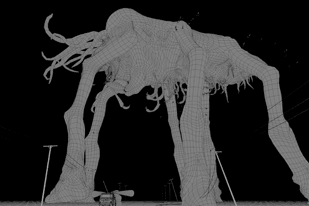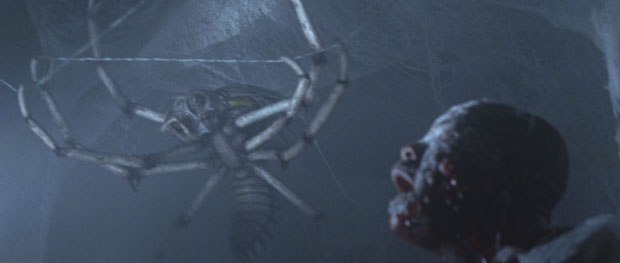Thomas J. McLean enters The Mist and discovers guerilla warfare from CafeFX.
Director Frank Darabont has had plenty of success adapting Stephen King's work on The Shawshank Redemption and The Green Mile, so taking on The Mist, a King novella first published in 1980, seemed like a natural for the director.
Visual Effects Supervisor Everett Burrell says Darabont chose CafeFX as the lead house on the film via a recommendation from Guillermo del Toro, who used the Santa Maria, Calif.-based shop on Pan's Labyrinth.
While The Mist is a fairly straightforward horror film about a small town enveloped in a heavy mist that brings other-dimensional creatures with it, the scariest thing for Burrell was the small budget and short schedule.
"We talked a lot about what to do and the reality set in about the budget," he says. "There was no money. The budget for the entire film was $17 million."
But the story had fans that were thrilled to be working on the project, regardless of the budget. "I almost fell out of my chair because The Mist is one of my long time favorite short stories or novellas from college," says CafeFX Animation Supervisor James Straus.
While the tight budget was a huge challenge, Darabont added a stylistic wrinkle that was going to have a huge impact on the vfx. "He'd directed an episode of The Shield," Burrell says. "The way they shoot that show is with two cameras at all times and basically the camera operators kind of grab these little moments. It's a very freeform style of filmmaking. Once I heard that, I realized the camera tracking was going to be a nightmare. We had to come up with a plan, we had to set rules like you can't zoom during effects shots."
The film was shot in Shreveport, La., in six weeks. "It was just like guerilla warfare and we tried to keep our heads above water," Burrell adds. "I was behind Frank the whole time so I could always hear and predict what he's thinking."
Burrell says they also collaborated with famed KNB, which created practical effects for the creatures. At times, the practical effects required digital tweaking or even replacement to get the look and movement that Darabont wanted.
To facilitate the vfx process, a photo model was created of the set. "[We] shot like 300 photos of the environment and stitched the environment together," Burrell explains. "We sent the whole set to CafeFX so they had a really good starting point."
Straus says it was also a huge boon to have a well-defined space for all the action to take place in. "We built the rooms first, before we had any creatures. We could go in with virtual cameras and could block out all the shots before we even had the characters constructed," he continues. Since they had the actual space built in scale, they could begin animating early in the process.

"That also allowed us to be very creative, since we're essentially filming inside this little environment. In some cases we added creatures and showed Frank alternative versions."
In fact, several of their suggestions made it into the film, improving its logic and look. One example was a scene where bird-like creatures broke into the market and began to attack the people. Originally, the creatures were supposed to be disoriented, having never encountered humans or structures, just flying around and terrorizing them. Straus says since the birds were eating insects outside the market, it made sense if they continued to eat the bugs as they entered the market and have the people just be sort of in their way until the birds notice they're edible too.
"Frank saw it, and he was ecstatic," Straus adds. "He ran with it, and had us add more bugs in there."
For creating digital versions of the on-set effects, Burrell took extensive photos of the puppets and practical creatures and effects created by KNB. "The maquettes are one thing, but it's always better to take photos of the actual puppets," Burrell says.
To meet the tight production schedule, Burrell was immediately sending scenes back to CafeFX at a rate of 20 to 30 GB per week.

Back in California, CafeFX modeled the bugs, tentacles and various creatures while shooting was going on. Straus says they created between eight and 10 creatures, including three basic styles of tentacles, the bird-like creatures, a crab monster, swarms of insects and giant spiders.
Returning from the shoot, Burrell began to tackle the mist itself. "Frank wanted it to look like an alien world had dumped a can of its atmosphere on Earth," he suggests. "I felt it should be subtle. When they first see it across the lake from the lake house, it can't be too scary. It has to look natural and kind of freaky."
While Burrell says his first inclination was to use cloud tank footage, they ended up creating elements in 3ds Max and rendering in Fume. The look was augmented with dry ice effects shot on stage and getting it just right took dozens of tries, especially since it involved simulations that never game the same result. They ended up combining several different elements and approaches into the final effect.
"We had two different effects artist working on the mist and it was totally cool because they had totally different ideas on how to do it," Burrell says. "One was too subtle, one was too extreme, but by combining the two, we came up with something really interesting."
Other challenges included creating a pipeline that revolved around the way the creatures had to interact with the environment.
Burrell says they tracked their shots against a flattened plate, and then placed the geometry so animators could work in an exactly tracked environment. The animation work was done in Maya, and exported to SOFTIMAGE|XSI for texture, lighting and rendering. Cost was a factor in the decision to use XSI, as it was cheaper than completing the work in Maya or other software, Burrell acknowledges.
Straus says his crew looked to nature to inspire the movements of the creatures, which had to be both familiar and otherworldly at the same time.
Under these constraints, getting the effects to render with motion blur and displacement was a real challenge, Burrell echoes. "It took a lot of jumping through hoops to get that to work."
Many of the effects done on set required paintwork and fixes, for which the film used Sony Pictures Imageworks India. "Some of the hardest paint fixes I've ever seen, they did them in a matter of days," Burrell insists.
Other vendors came in for specific tasks. For example, Digital Dream removed the light reflections on the cars on the parking lot set and the occasional crewmember. "The style of the filmmaking was so fast and furious that they got a little sloppy and you could see the camera catch a moment and you could see four crew members standing behind a car or something," Burrell says.
The work on the feature was rough, with a crew that maxed out at about 40 turning out 200 shots for the film. But the challenge of making each film better than the last is part of the fun, Straus says. "No matter how good the computers get, the director and the studios up the ante each time."
Thomas J. McLean is a freelance journalist whose articles have appeared in Variety, Below the Line, Animation Magazine and Publishers Weekly. He writes a comicbook blog for Variety.com called Bags and Boards, and is the author of Mutant Cinema: The X-Men Trilogy from Comics to Screen, forthcoming from Sequart.com Books.










